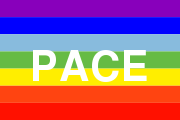Rainbow flag
A rainbow flag is a multi-colored flag consisting of stripes in the colors of the rainbow. The actual colors used differ, but many of the designs are based on the traditional scheme of red, orange, yellow, green, blue, indigo and violet, or some more modern division of the rainbow spectrum (often excluding indigo, and sometimes including cyan instead).
The use of rainbow flags has a long tradition; they are displayed in many cultures around the world as a sign of diversity and inclusiveness, of hope and of yearning.
There are several unrelated rainbow flags in use today. The most widely known is perhaps the pride flag representing gay pride. The peace flag is especially popular in Italy and the cooperative flag symbolizes international cooperation. It is also used by Andean people to represent the legacy of the Inca empire (Wiphala) and Andean movements.
Contents |
Rainbow flags in various cultures and movements
Early European history
The use of rainbow flags as a sign of diversity, inclusiveness, hope and of yearning has a long history. This denotation goes back to the rainbow as a symbol of biblical promise, when God used the rainbow as a sign to Noah that there would never be a flood like the one that happened.[1][2] The reformer Thomas Müntzer (1489-1525) connected socially revolutionary claims with his preaching of the gospel. He is often portrayed with a rainbow flag in his hand. The Thomas Müntzer statue in the German town of Stolberg also shows him holding a rainbow flag in his hand.
In the German Peasants' War of the 16th century, the rainbow flag together with the peasants' boot ("Bundschuh") was used as the sign of a new era, of hope and of social change.
South America (Pre-Columbian)
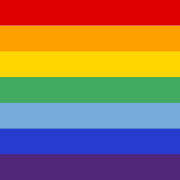
A flag with a seven-striped rainbow design is used in Peru [3] and Ecuador to represent Tawantin Suyu, or Inca territory. The use of the flag has its origin in Inca culture and it is called wiphala. Even today in the city of Cusco, Peru it is common to see the flag around the city displayed even in government buildings and in Cusco main square. The meaning behind the whipala has to be found in connection with the Incas and with the cosmovision and philosophy of Andean indigenous culture.
Some argue that there is no historical reference to an Inca or Tawantisuyo flag or banner until the early 1920s; but other specialists suggest that there are chronicles and some references that support the idea of a banner attributable to the Inca. In 1534 during the invasion and occupation of the city of Qusqu today Cusco, the Spaniards found the first resistance of qhishwa-ayrnaras and saw between the multitude, objects similar to the flag of strips and pictures of seven colors of the rainbow. The existence and the use of this emblem probably has been from the same creation of Tiwanaku for more than 2000 years. [4] [5]
Cooperative movement (1921)
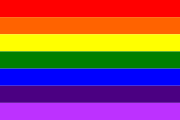
A seven-colour rainbow flag is a common symbol of the international cooperative movement. The rainbow flag has been the cooperative emblem since 1921 when the International Co-operative Congress of World Co-op Leaders met in Basel, Switzerland to identify and define the growing cooperative movement’s common values and ideals to help unite co-ops around the world.
In Essen, Germany in 1922, the International Co-operative Alliance (ICA) designed an international co-op symbol and a flag for the first "Co-operators' Day," which was held in July 1923. After some experiments with different designs, a famous French cooperator, Professor Charles Gide, suggested using the seven colours of the rainbow for the flag. He pointed out that the rainbow symbolized unity in diversity and the power of light, enlightenment and progress. The first co-op rainbow flag was completed in 1924 and was adopted as an official symbol of the international cooperative movement in 1925.
In 2001, the ICA's official flag was changed from a rainbow flag to a rainbow logo flag on a white field, to clearly promote and strengthen the cooperative image, but still use the rainbow image. Other organizations sometimes use the traditional rainbow flag as a symbol of cooperation.
Like the rainbow, this flag is a symbol of hope and peace. The seven colours from flags around the world fly in harmony. Each of the seven colours in the co-operative flag have been assigned the following meaning:
The ICA has been flying a flag with its official logo since April 2001, when its Board decided to replace the traditional rainbow flag. Its use by a number of non-cooperative groups led to confusion in several countries around the world.
- red: stands for courage;
- orange: offers the vision of possibilities;
- yellow: represents the challenge that GREEN has kindled;
- green: indicates a challenge to co-operators to strive for growth of membership and of understanding of the aims and values of co-operation;
- sky blue: suggests far horizons, the need to provide education and help less fortunate people and strive toward global unity.
- dark blue: suggests pessimism: a reminder that less fortunate people have needs that may be met through the benefits of cooperation.
- violet: is the colour of warmth, beauty, and friendship.
– ICA, [6]
Meher Baba (1924)
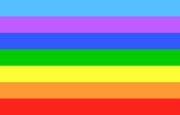
Meher Baba designed a rainbow flag on April 23, 1924. It is flown each year near his samadhi (tomb-shrine) in Meherabad, India during the week of Amartithi (the anniversary of his death on January 31, 1969). Baba explained the symbolism, saying, "The colors in the flag signify man's rise from the grossest of impressions of lust and anger – symbolized by red – to the culmination in the highest state of spirituality and oneness with God – symbolized by sky blue." [7] [8]
Peace movement (1961)
This rainbow flag in Italy was first used in a peace march in 1961, inspired by similar multi-coloured flags used in demonstrations against nuclear weapons. It became popular with the Pace da tutti i balconi ("peace from every balcony") campaign in 2002, started as a protest against the impending war in Iraq. The most common variety has seven colours, purple, blue, azure, green, yellow, orange and red, and is emblazoned in bold with the Italian word PACE, meaning "peace". [9] [10]
Common variations include moving the purple stripe down below the azure one, and adding a white stripe on top (the original flag from the 60s had a white stripe on top). This flag has been adopted internationally as a symbol of the peace movement.
LGBT (Lesbian, Gay, Bisexual, Transgender) Pride (1978)
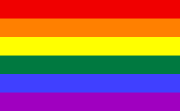
The rainbow flag, sometimes called 'the freedom flag', was popularized as a symbol of lesbian, gay, bisexual and transgender (LGBT) pride and diversity by San Francisco artist Gilbert Baker in 1978. The different colours symbolize diversity in the gay community, and the flag is used predominantly at gay pride events and in gay villages worldwide in various forms including banners, clothing and jewelry. For the 25th Anniversary of the Stonewall riots held in 1994 in New York city a mile-long rainbow flag was created and post-parade cut up in sections that have since been used around the world.
Originally created with eight colors, pink and turquoise were removed for production purposes and as of 2008, it consists of six colored stripes, which should always be displayed with red on top or to left. Aside from the obvious symbolism of a mixed LGBT community, the colors were designed to symbolize: red (life), orange (healing), yellow (sunlight), green (nature), blue (harmony), and purple/violet (spirit). It is most commonly flown with the red stripe on top, as the colours appear in a natural rainbow.[11]
Jewish Autonomous Oblast (1996)
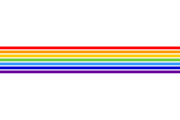
Another variation of rainbow flag is used by Jewish Autonomous Oblast, situated in the Far Eastern Federal District of Russia, by the Chinese border. The stripes symbolize the rainbow. The white field may be reminiscent of the Israeli flag. Proportions 2:3. Adopted first of October 1996. [12]
The Jewish Autonomous Oblast has a flag with a seven-colour rainbow. The number of colours is meant to symbolize the seven-branched Jewish Menorah.
Pachakutik political party
In Ecuador, a rainbow flag is used by the "Pachakutik" political party: a political party made up of mostly of indigenous people.
Noachides
In religion, Noahides use rainbow flags and symbols as signs of their faith - the rainbow representing the covenant with God after the flood and the seven colours representing each of the Laws.
Gallery of rainbow flags
References
- ↑ Christian symbols Glossary
- ↑ Symbol of God's Everlasting Covenant with Mankind
- ↑ Flagspot.net
- ↑ History of Wiphala
- ↑ Social Design Notes: The Wiphala
- ↑ Official website of ICA
- ↑ Lord Meher, by Bhau Kalchuri, Manifestation Inc. 1986, p. 618
- ↑ The History of Meher Baba's Rainbow Flag
- ↑ Bandiere di Pace.org ('Flags of Peace' in Italian)
- ↑ Amnesty International
- ↑ History of the Gay Pride Rainbow Flag
- ↑ Jewish Autonomous Region (Russia)

